| B i o g r a p h y |
 With his Botticelli face and curls and whimsically glamorous image, Marc Bolan fronted T. Rex,
a British group that generated a fan hysteria reminiscent of
Beatlemania and produced 11 successive U.K. Top 10 hits between 1970
and 1974. Among these were "Bang a Gong (Get It On)" (#1), "Jeepster"
(#2), and "Telegram Sam" (#1). But while T. Rex could not hardly
duplicate its British success in America (where its sole major hit was
the Top 10 smash "Bang a Gong") the group's heavy guitar sound has had
an enduring influence and can be heard in songs such as Love and
Rockets’ “I’m Alive” and groups like the Soup Dragons.
With his Botticelli face and curls and whimsically glamorous image, Marc Bolan fronted T. Rex,
a British group that generated a fan hysteria reminiscent of
Beatlemania and produced 11 successive U.K. Top 10 hits between 1970
and 1974. Among these were "Bang a Gong (Get It On)" (#1), "Jeepster"
(#2), and "Telegram Sam" (#1). But while T. Rex could not hardly
duplicate its British success in America (where its sole major hit was
the Top 10 smash "Bang a Gong") the group's heavy guitar sound has had
an enduring influence and can be heard in songs such as Love and
Rockets’ “I’m Alive” and groups like the Soup Dragons.
T. Rex had its beginnings when the group - known as Tyrannosaurus Rex until the 1970 success of “Ride a White Swan” - was formed by Bolan in 1967 with Steve Peregrin (often misspelled Peregrine) Took. A well-known scene-making Mod in the early ’60s, Bolan released two singles in the mid-’60s on Decca - “Hippy Gumbo” and “The Wizard” - which failed to establish him as a solo artist. But with the group John’s Children, Bolan enjoyed two minor U.K. hits in 1967 - “Desdemona” and “Go Go Girl.” One year later, Tyrannosaurus Rex recorded its debut album (produced by Tony Visconti), which blended acoustic textures with such instruments as the Chinese gong and talking drums and accented Bolan’s lyrics - a blend of myth, fantasy, and magic (others might say utter nonsense). As a British flower-power band, Tyrannosaurus Rex earned a sizable underground following and toured the U.S. in 1969.
The band began to achieve widespread success by embracing a full-blown rock attack on albums like Electric Warrior (#32, 1971) (which, like many of the group’s hits, included backing vocals by Flo and Eddie). The group’s highest-charting U.S. release was The Slider (#17, 1972). During the height of T. Rex mania in 1973, Ringo Starr directed a documentary on the group’s success, Born to Boogie. Bolan and the group were at the forefront of the glitter movement, which was far more influential and lasting in their homeland than in the U.S. T. Rex’s popularity declined shortly thereafter, and Bolan declared the group extinct in 1975, leaving his wife and exiling himself to America. He returned to England in 1976 and began living with American singer Gloria Jones. Respected by followers of the then burgeoning new-wave scene, Bolan brought the Damned on tour with his newly re-formed T. Rex in 1977 as a support act.
But his solo career never took off in the U.S., partly because of
his haphazard personal life. “I was living in a twilight world of
drugs, booze, and kinky sex,” he told ROLLING STONE. Bolan died in a
crash on September 16, 1977, in a car driven by Jones. In 1980 Steve
Took died from choking on a cherry while high on morphine. In 2001
Mickey Finn toured with his own “T-Rex.”